Multinational Companies: Improving HR for International Standards
VerifiedAdded on 2021/02/19
|35
|4352
|20
Report
AI Summary
This report investigates how multinational companies, using Nestle as a case study, enhance their human resource practices to meet international standards. It begins with an introduction outlining the importance of adapting HR policies for globalization, emphasizing the need for changes in recruitment, selection, and training to attract a diverse and skilled workforce. The report presents a project management plan (PMP) with defined scopes, timelines, and risk assessments. A comprehensive literature review explores the significance of recruitment, selection, and training, and suggests improvements such as optimizing hiring processes and building an employer brand. The report also analyzes survey data to assess opinions on the importance of HR practices, the impact of recruitment changes on productivity, and the need for training sessions. The findings highlight the importance of considering competition, international employment law, and company culture in developing HR policies. The report concludes with the key findings and recommendations for Nestle and other multinational companies seeking to improve their HR strategies for global success.
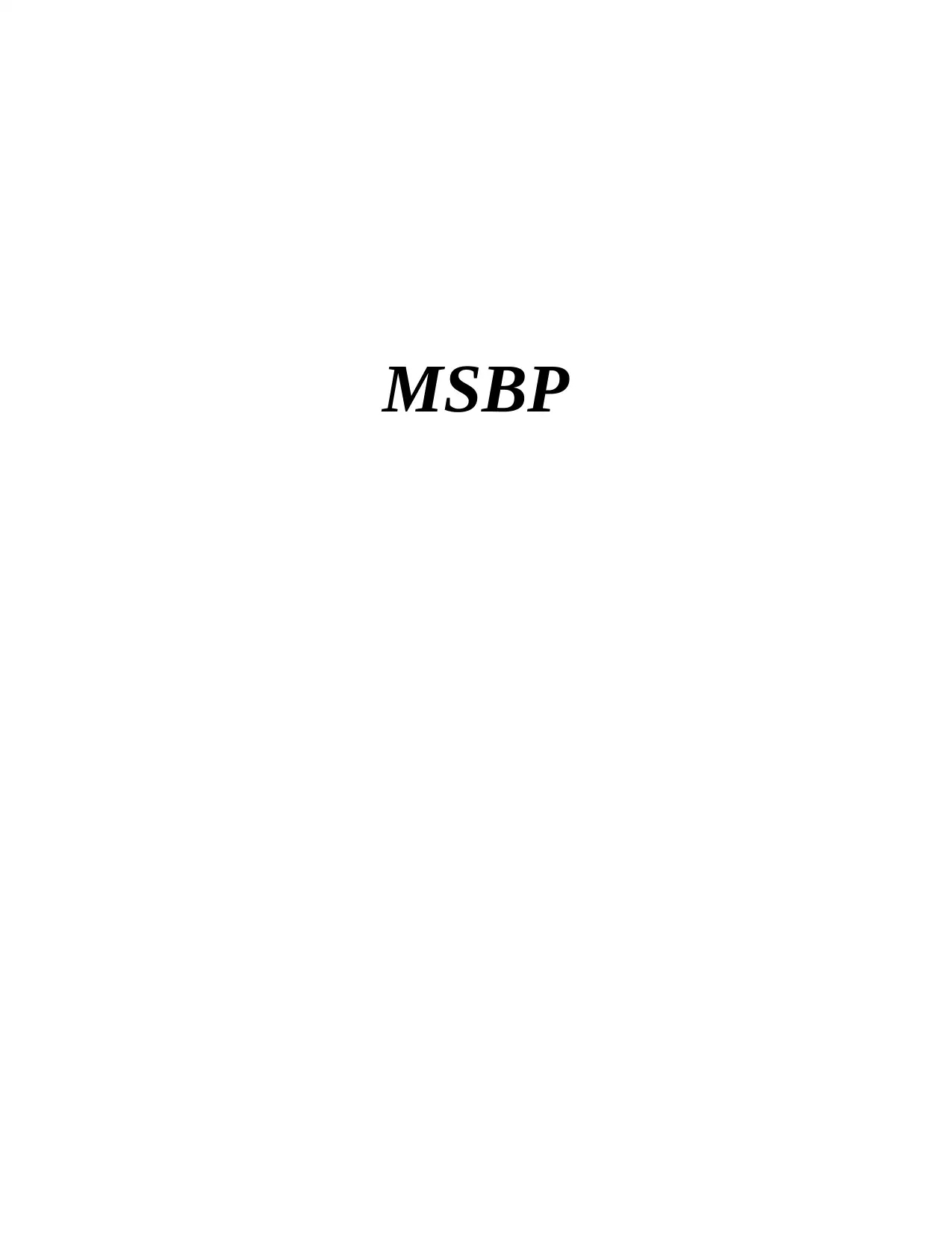
MSBP
Paraphrase This Document
Need a fresh take? Get an instant paraphrase of this document with our AI Paraphraser
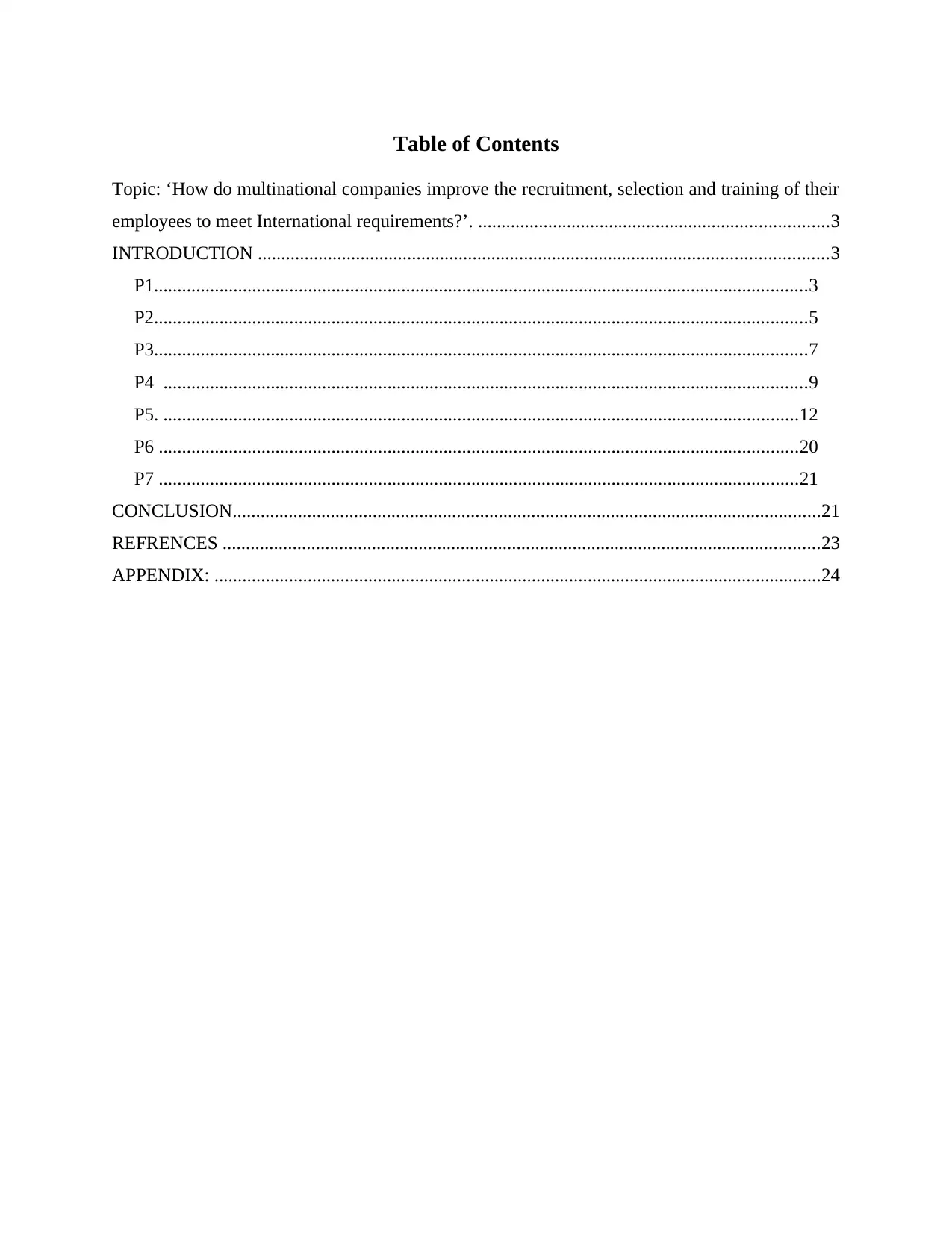
Table of Contents
Topic: ‘How do multinational companies improve the recruitment, selection and training of their
employees to meet International requirements?’. ...........................................................................3
INTRODUCTION ..........................................................................................................................3
P1............................................................................................................................................3
P2............................................................................................................................................5
P3............................................................................................................................................7
P4 ..........................................................................................................................................9
P5. ........................................................................................................................................12
P6 .........................................................................................................................................20
P7 .........................................................................................................................................21
CONCLUSION..............................................................................................................................21
REFRENCES ................................................................................................................................23
APPENDIX: ..................................................................................................................................24
Topic: ‘How do multinational companies improve the recruitment, selection and training of their
employees to meet International requirements?’. ...........................................................................3
INTRODUCTION ..........................................................................................................................3
P1............................................................................................................................................3
P2............................................................................................................................................5
P3............................................................................................................................................7
P4 ..........................................................................................................................................9
P5. ........................................................................................................................................12
P6 .........................................................................................................................................20
P7 .........................................................................................................................................21
CONCLUSION..............................................................................................................................21
REFRENCES ................................................................................................................................23
APPENDIX: ..................................................................................................................................24
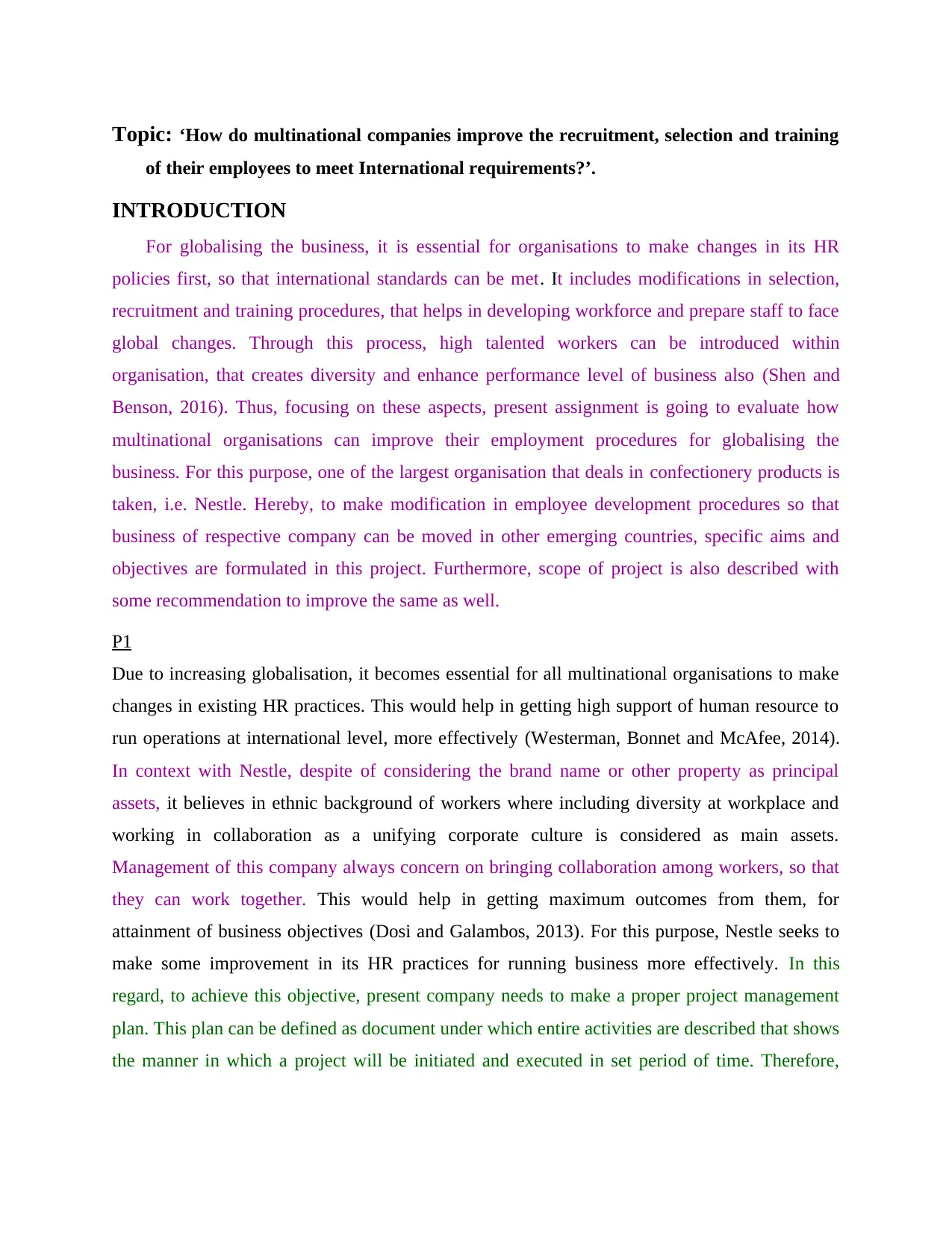
Topic: ‘How do multinational companies improve the recruitment, selection and training
of their employees to meet International requirements?’.
INTRODUCTION
For globalising the business, it is essential for organisations to make changes in its HR
policies first, so that international standards can be met. It includes modifications in selection,
recruitment and training procedures, that helps in developing workforce and prepare staff to face
global changes. Through this process, high talented workers can be introduced within
organisation, that creates diversity and enhance performance level of business also (Shen and
Benson, 2016). Thus, focusing on these aspects, present assignment is going to evaluate how
multinational organisations can improve their employment procedures for globalising the
business. For this purpose, one of the largest organisation that deals in confectionery products is
taken, i.e. Nestle. Hereby, to make modification in employee development procedures so that
business of respective company can be moved in other emerging countries, specific aims and
objectives are formulated in this project. Furthermore, scope of project is also described with
some recommendation to improve the same as well.
P1
Due to increasing globalisation, it becomes essential for all multinational organisations to make
changes in existing HR practices. This would help in getting high support of human resource to
run operations at international level, more effectively (Westerman, Bonnet and McAfee, 2014).
In context with Nestle, despite of considering the brand name or other property as principal
assets, it believes in ethnic background of workers where including diversity at workplace and
working in collaboration as a unifying corporate culture is considered as main assets.
Management of this company always concern on bringing collaboration among workers, so that
they can work together. This would help in getting maximum outcomes from them, for
attainment of business objectives (Dosi and Galambos, 2013). For this purpose, Nestle seeks to
make some improvement in its HR practices for running business more effectively. In this
regard, to achieve this objective, present company needs to make a proper project management
plan. This plan can be defined as document under which entire activities are described that shows
the manner in which a project will be initiated and executed in set period of time. Therefore,
of their employees to meet International requirements?’.
INTRODUCTION
For globalising the business, it is essential for organisations to make changes in its HR
policies first, so that international standards can be met. It includes modifications in selection,
recruitment and training procedures, that helps in developing workforce and prepare staff to face
global changes. Through this process, high talented workers can be introduced within
organisation, that creates diversity and enhance performance level of business also (Shen and
Benson, 2016). Thus, focusing on these aspects, present assignment is going to evaluate how
multinational organisations can improve their employment procedures for globalising the
business. For this purpose, one of the largest organisation that deals in confectionery products is
taken, i.e. Nestle. Hereby, to make modification in employee development procedures so that
business of respective company can be moved in other emerging countries, specific aims and
objectives are formulated in this project. Furthermore, scope of project is also described with
some recommendation to improve the same as well.
P1
Due to increasing globalisation, it becomes essential for all multinational organisations to make
changes in existing HR practices. This would help in getting high support of human resource to
run operations at international level, more effectively (Westerman, Bonnet and McAfee, 2014).
In context with Nestle, despite of considering the brand name or other property as principal
assets, it believes in ethnic background of workers where including diversity at workplace and
working in collaboration as a unifying corporate culture is considered as main assets.
Management of this company always concern on bringing collaboration among workers, so that
they can work together. This would help in getting maximum outcomes from them, for
attainment of business objectives (Dosi and Galambos, 2013). For this purpose, Nestle seeks to
make some improvement in its HR practices for running business more effectively. In this
regard, to achieve this objective, present company needs to make a proper project management
plan. This plan can be defined as document under which entire activities are described that shows
the manner in which a project will be initiated and executed in set period of time. Therefore,
⊘ This is a preview!⊘
Do you want full access?
Subscribe today to unlock all pages.

Trusted by 1+ million students worldwide
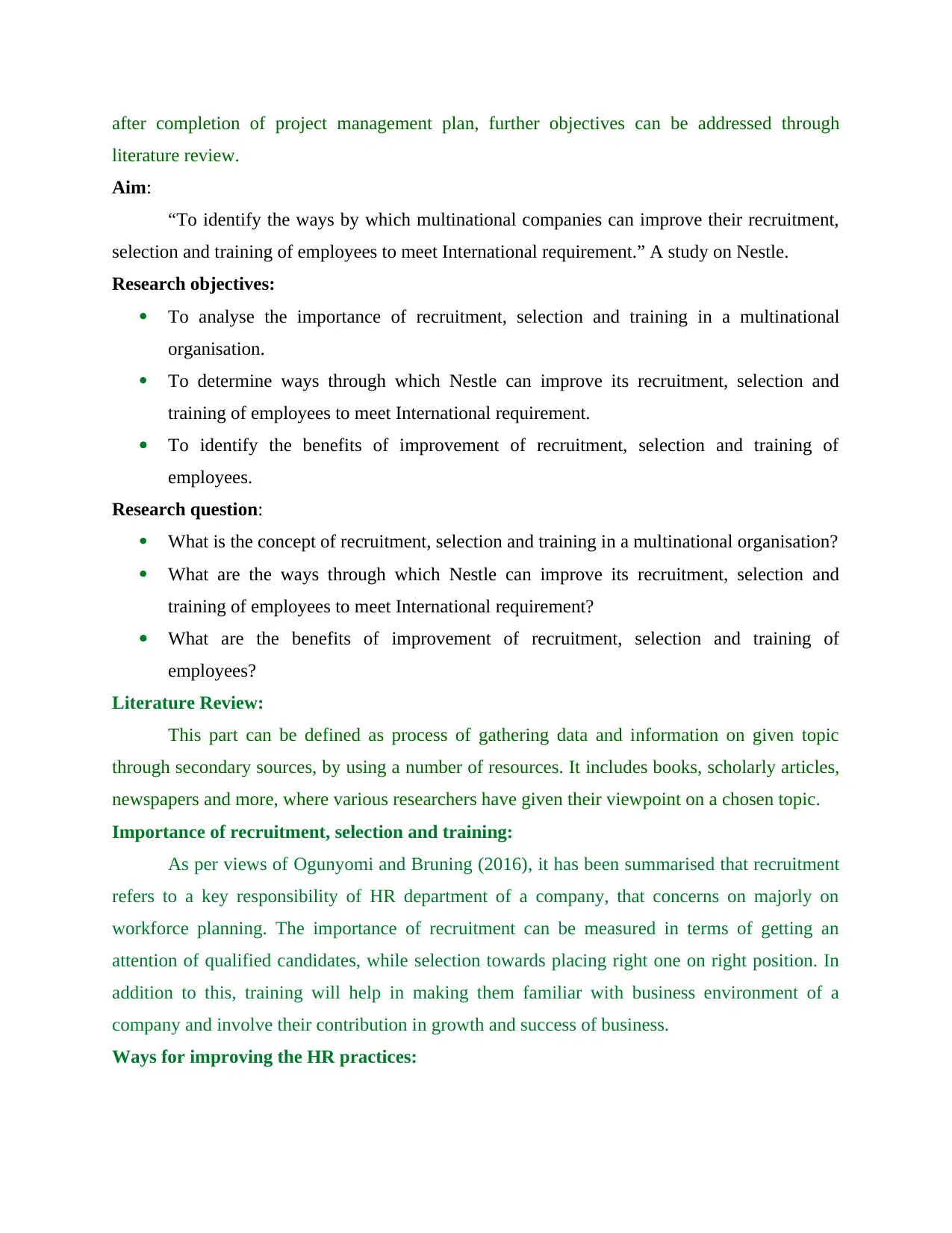
after completion of project management plan, further objectives can be addressed through
literature review.
Aim:
“To identify the ways by which multinational companies can improve their recruitment,
selection and training of employees to meet International requirement.” A study on Nestle.
Research objectives:
To analyse the importance of recruitment, selection and training in a multinational
organisation.
To determine ways through which Nestle can improve its recruitment, selection and
training of employees to meet International requirement.
To identify the benefits of improvement of recruitment, selection and training of
employees.
Research question:
What is the concept of recruitment, selection and training in a multinational organisation?
What are the ways through which Nestle can improve its recruitment, selection and
training of employees to meet International requirement?
What are the benefits of improvement of recruitment, selection and training of
employees?
Literature Review:
This part can be defined as process of gathering data and information on given topic
through secondary sources, by using a number of resources. It includes books, scholarly articles,
newspapers and more, where various researchers have given their viewpoint on a chosen topic.
Importance of recruitment, selection and training:
As per views of Ogunyomi and Bruning (2016), it has been summarised that recruitment
refers to a key responsibility of HR department of a company, that concerns on majorly on
workforce planning. The importance of recruitment can be measured in terms of getting an
attention of qualified candidates, while selection towards placing right one on right position. In
addition to this, training will help in making them familiar with business environment of a
company and involve their contribution in growth and success of business.
Ways for improving the HR practices:
literature review.
Aim:
“To identify the ways by which multinational companies can improve their recruitment,
selection and training of employees to meet International requirement.” A study on Nestle.
Research objectives:
To analyse the importance of recruitment, selection and training in a multinational
organisation.
To determine ways through which Nestle can improve its recruitment, selection and
training of employees to meet International requirement.
To identify the benefits of improvement of recruitment, selection and training of
employees.
Research question:
What is the concept of recruitment, selection and training in a multinational organisation?
What are the ways through which Nestle can improve its recruitment, selection and
training of employees to meet International requirement?
What are the benefits of improvement of recruitment, selection and training of
employees?
Literature Review:
This part can be defined as process of gathering data and information on given topic
through secondary sources, by using a number of resources. It includes books, scholarly articles,
newspapers and more, where various researchers have given their viewpoint on a chosen topic.
Importance of recruitment, selection and training:
As per views of Ogunyomi and Bruning (2016), it has been summarised that recruitment
refers to a key responsibility of HR department of a company, that concerns on majorly on
workforce planning. The importance of recruitment can be measured in terms of getting an
attention of qualified candidates, while selection towards placing right one on right position. In
addition to this, training will help in making them familiar with business environment of a
company and involve their contribution in growth and success of business.
Ways for improving the HR practices:
Paraphrase This Document
Need a fresh take? Get an instant paraphrase of this document with our AI Paraphraser
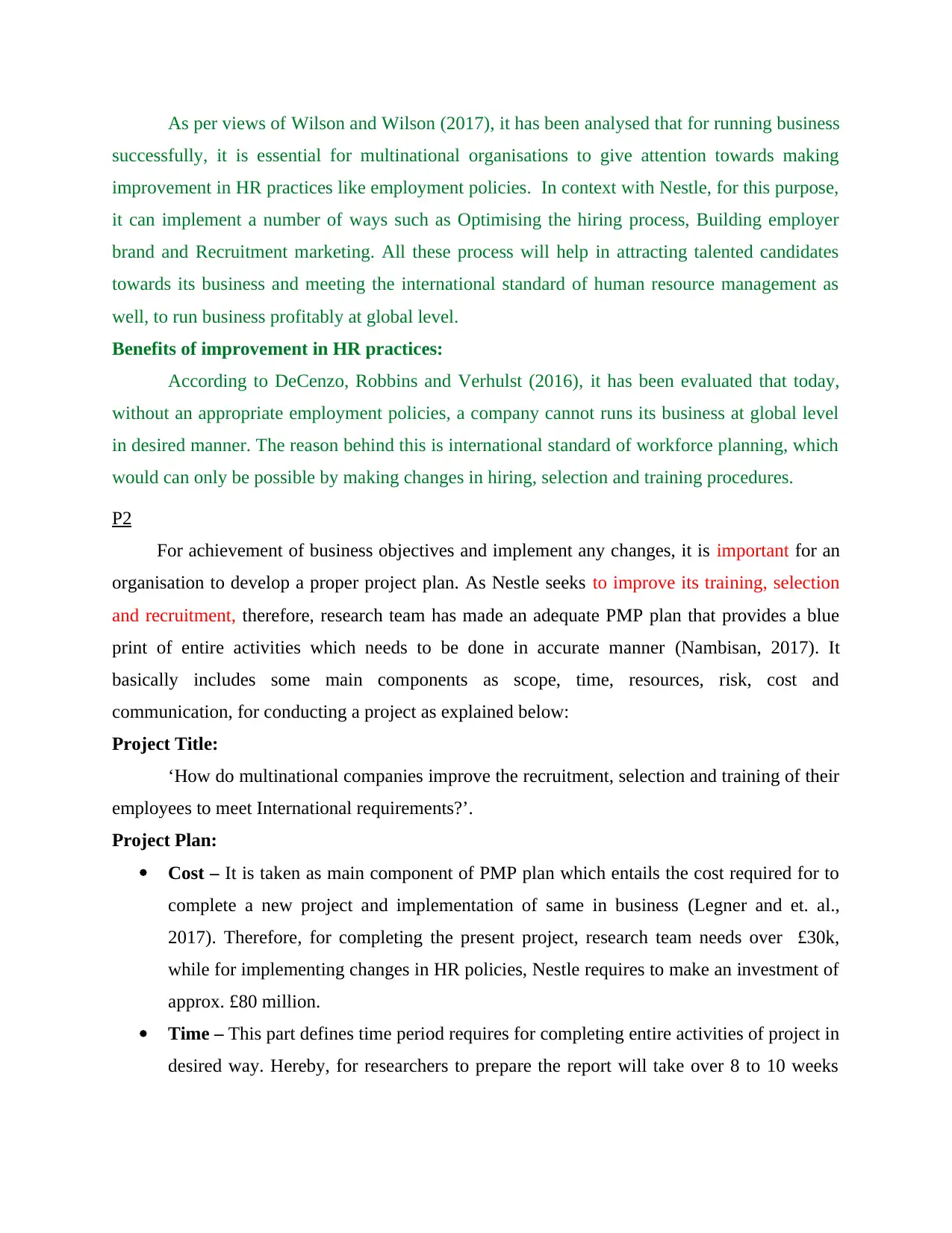
As per views of Wilson and Wilson (2017), it has been analysed that for running business
successfully, it is essential for multinational organisations to give attention towards making
improvement in HR practices like employment policies. In context with Nestle, for this purpose,
it can implement a number of ways such as Optimising the hiring process, Building employer
brand and Recruitment marketing. All these process will help in attracting talented candidates
towards its business and meeting the international standard of human resource management as
well, to run business profitably at global level.
Benefits of improvement in HR practices:
According to DeCenzo, Robbins and Verhulst (2016), it has been evaluated that today,
without an appropriate employment policies, a company cannot runs its business at global level
in desired manner. The reason behind this is international standard of workforce planning, which
would can only be possible by making changes in hiring, selection and training procedures.
P2
For achievement of business objectives and implement any changes, it is important for an
organisation to develop a proper project plan. As Nestle seeks to improve its training, selection
and recruitment, therefore, research team has made an adequate PMP plan that provides a blue
print of entire activities which needs to be done in accurate manner (Nambisan, 2017). It
basically includes some main components as scope, time, resources, risk, cost and
communication, for conducting a project as explained below:
Project Title:
‘How do multinational companies improve the recruitment, selection and training of their
employees to meet International requirements?’.
Project Plan:
Cost – It is taken as main component of PMP plan which entails the cost required for to
complete a new project and implementation of same in business (Legner and et. al.,
2017). Therefore, for completing the present project, research team needs over £30k,
while for implementing changes in HR policies, Nestle requires to make an investment of
approx. £80 million.
Time – This part defines time period requires for completing entire activities of project in
desired way. Hereby, for researchers to prepare the report will take over 8 to 10 weeks
successfully, it is essential for multinational organisations to give attention towards making
improvement in HR practices like employment policies. In context with Nestle, for this purpose,
it can implement a number of ways such as Optimising the hiring process, Building employer
brand and Recruitment marketing. All these process will help in attracting talented candidates
towards its business and meeting the international standard of human resource management as
well, to run business profitably at global level.
Benefits of improvement in HR practices:
According to DeCenzo, Robbins and Verhulst (2016), it has been evaluated that today,
without an appropriate employment policies, a company cannot runs its business at global level
in desired manner. The reason behind this is international standard of workforce planning, which
would can only be possible by making changes in hiring, selection and training procedures.
P2
For achievement of business objectives and implement any changes, it is important for an
organisation to develop a proper project plan. As Nestle seeks to improve its training, selection
and recruitment, therefore, research team has made an adequate PMP plan that provides a blue
print of entire activities which needs to be done in accurate manner (Nambisan, 2017). It
basically includes some main components as scope, time, resources, risk, cost and
communication, for conducting a project as explained below:
Project Title:
‘How do multinational companies improve the recruitment, selection and training of their
employees to meet International requirements?’.
Project Plan:
Cost – It is taken as main component of PMP plan which entails the cost required for to
complete a new project and implementation of same in business (Legner and et. al.,
2017). Therefore, for completing the present project, research team needs over £30k,
while for implementing changes in HR policies, Nestle requires to make an investment of
approx. £80 million.
Time – This part defines time period requires for completing entire activities of project in
desired way. Hereby, for researchers to prepare the report will take over 8 to 10 weeks
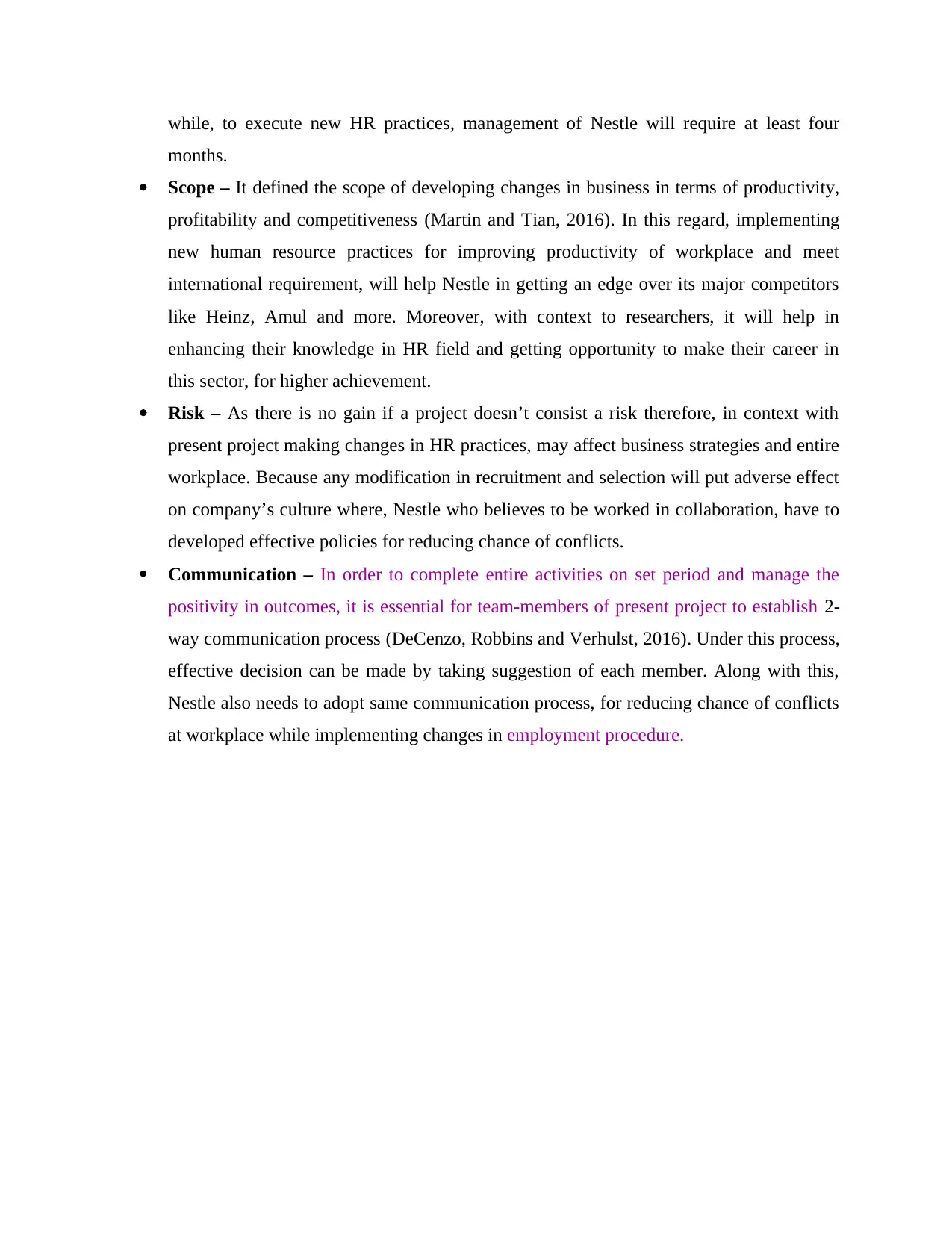
while, to execute new HR practices, management of Nestle will require at least four
months.
Scope – It defined the scope of developing changes in business in terms of productivity,
profitability and competitiveness (Martin and Tian, 2016). In this regard, implementing
new human resource practices for improving productivity of workplace and meet
international requirement, will help Nestle in getting an edge over its major competitors
like Heinz, Amul and more. Moreover, with context to researchers, it will help in
enhancing their knowledge in HR field and getting opportunity to make their career in
this sector, for higher achievement.
Risk – As there is no gain if a project doesn’t consist a risk therefore, in context with
present project making changes in HR practices, may affect business strategies and entire
workplace. Because any modification in recruitment and selection will put adverse effect
on company’s culture where, Nestle who believes to be worked in collaboration, have to
developed effective policies for reducing chance of conflicts.
Communication – In order to complete entire activities on set period and manage the
positivity in outcomes, it is essential for team-members of present project to establish 2-
way communication process (DeCenzo, Robbins and Verhulst, 2016). Under this process,
effective decision can be made by taking suggestion of each member. Along with this,
Nestle also needs to adopt same communication process, for reducing chance of conflicts
at workplace while implementing changes in employment procedure.
months.
Scope – It defined the scope of developing changes in business in terms of productivity,
profitability and competitiveness (Martin and Tian, 2016). In this regard, implementing
new human resource practices for improving productivity of workplace and meet
international requirement, will help Nestle in getting an edge over its major competitors
like Heinz, Amul and more. Moreover, with context to researchers, it will help in
enhancing their knowledge in HR field and getting opportunity to make their career in
this sector, for higher achievement.
Risk – As there is no gain if a project doesn’t consist a risk therefore, in context with
present project making changes in HR practices, may affect business strategies and entire
workplace. Because any modification in recruitment and selection will put adverse effect
on company’s culture where, Nestle who believes to be worked in collaboration, have to
developed effective policies for reducing chance of conflicts.
Communication – In order to complete entire activities on set period and manage the
positivity in outcomes, it is essential for team-members of present project to establish 2-
way communication process (DeCenzo, Robbins and Verhulst, 2016). Under this process,
effective decision can be made by taking suggestion of each member. Along with this,
Nestle also needs to adopt same communication process, for reducing chance of conflicts
at workplace while implementing changes in employment procedure.
⊘ This is a preview!⊘
Do you want full access?
Subscribe today to unlock all pages.

Trusted by 1+ million students worldwide
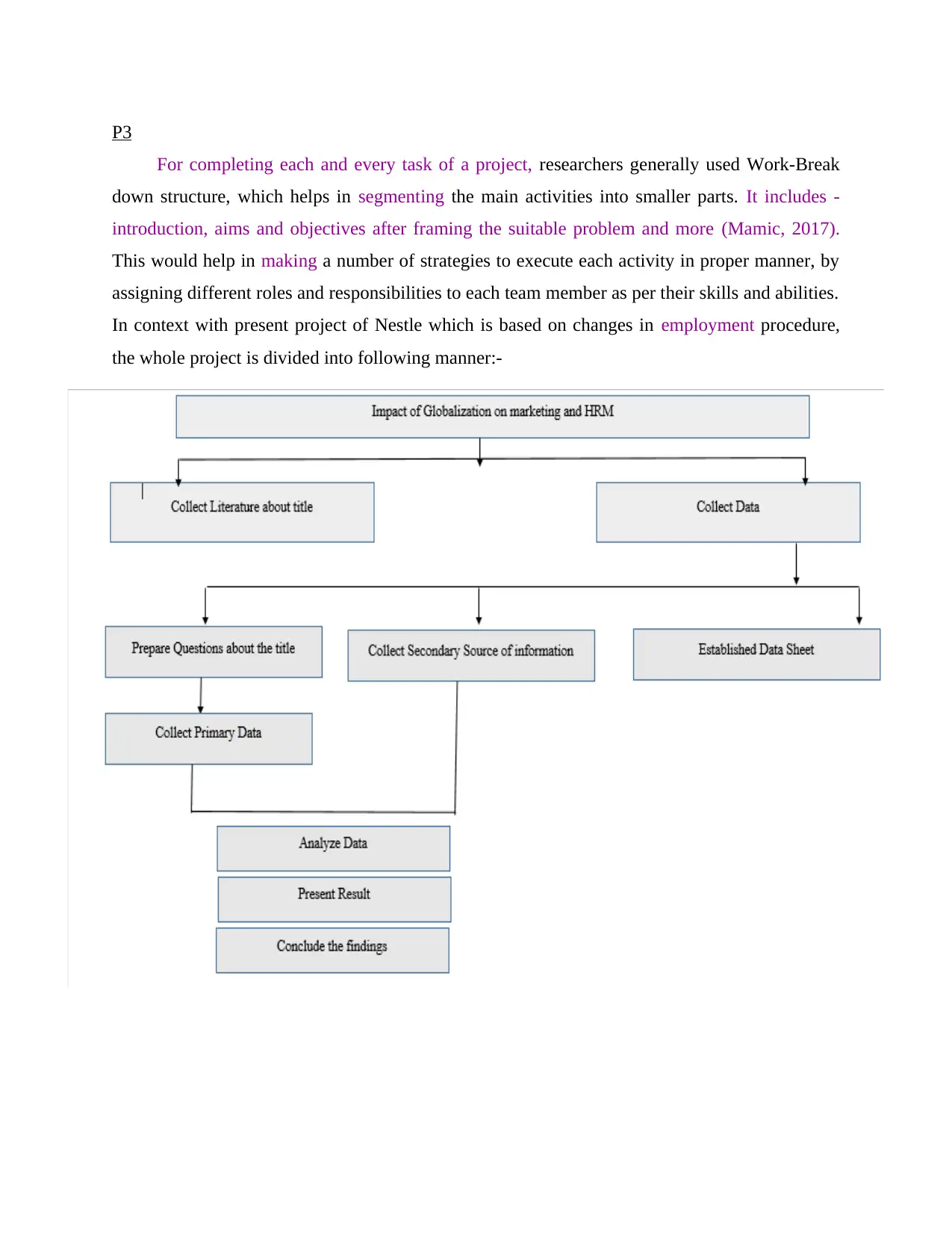
P3
For completing each and every task of a project, researchers generally used Work-Break
down structure, which helps in segmenting the main activities into smaller parts. It includes -
introduction, aims and objectives after framing the suitable problem and more (Mamic, 2017).
This would help in making a number of strategies to execute each activity in proper manner, by
assigning different roles and responsibilities to each team member as per their skills and abilities.
In context with present project of Nestle which is based on changes in employment procedure,
the whole project is divided into following manner:-
For completing each and every task of a project, researchers generally used Work-Break
down structure, which helps in segmenting the main activities into smaller parts. It includes -
introduction, aims and objectives after framing the suitable problem and more (Mamic, 2017).
This would help in making a number of strategies to execute each activity in proper manner, by
assigning different roles and responsibilities to each team member as per their skills and abilities.
In context with present project of Nestle which is based on changes in employment procedure,
the whole project is divided into following manner:-
Paraphrase This Document
Need a fresh take? Get an instant paraphrase of this document with our AI Paraphraser
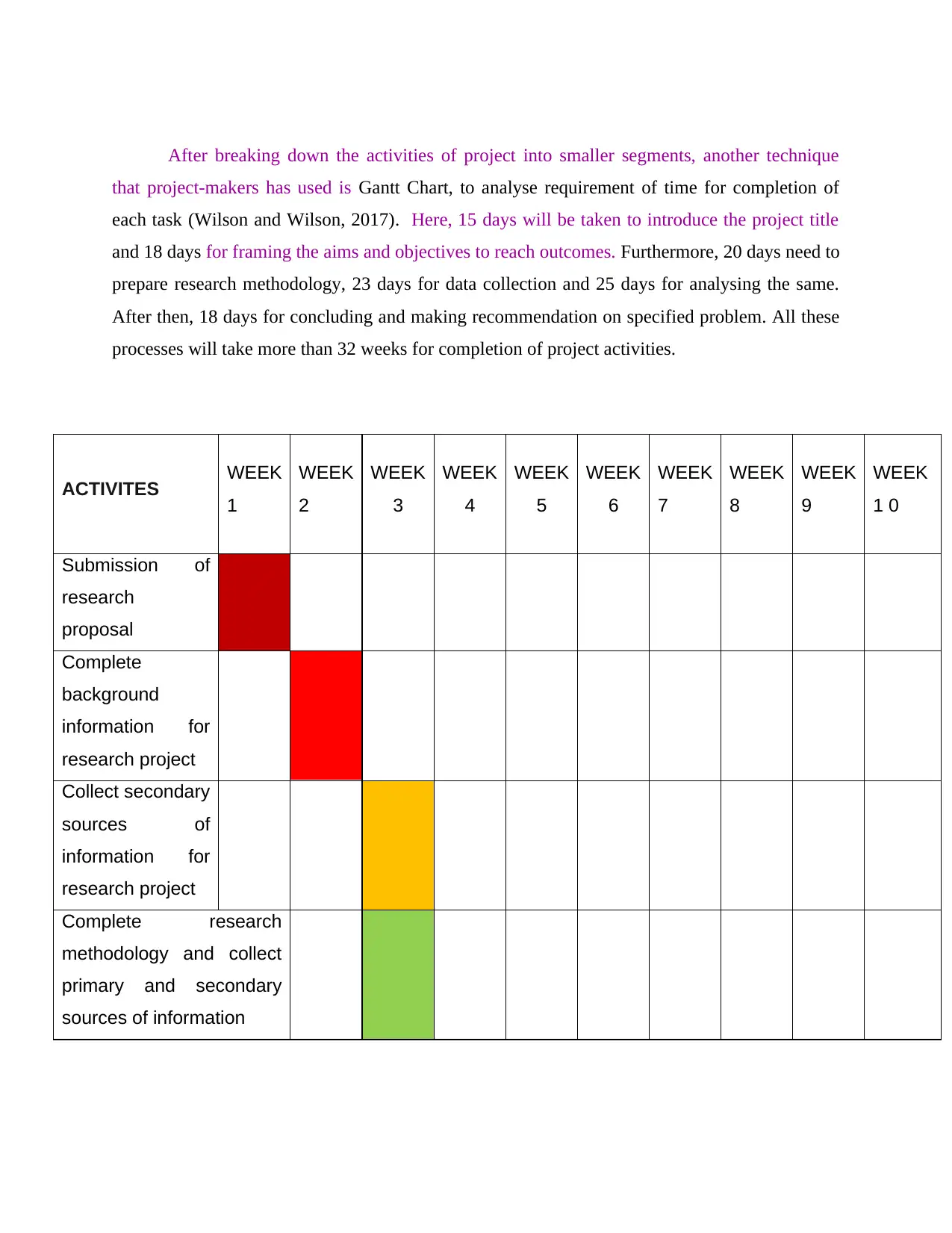
After breaking down the activities of project into smaller segments, another technique
that project-makers has used is Gantt Chart, to analyse requirement of time for completion of
each task (Wilson and Wilson, 2017). Here, 15 days will be taken to introduce the project title
and 18 days for framing the aims and objectives to reach outcomes. Furthermore, 20 days need to
prepare research methodology, 23 days for data collection and 25 days for analysing the same.
After then, 18 days for concluding and making recommendation on specified problem. All these
processes will take more than 32 weeks for completion of project activities.
ACTIVITES WEEK
1
WEEK
2
WEEK
3
WEEK
4
WEEK
5
WEEK
6
WEEK
7
WEEK
8
WEEK
9
WEEK
1 0
Submission of
research
proposal
Complete
background
information for
research project
Collect secondary
sources of
information for
research project
Complete research
methodology and collect
primary and secondary
sources of information
that project-makers has used is Gantt Chart, to analyse requirement of time for completion of
each task (Wilson and Wilson, 2017). Here, 15 days will be taken to introduce the project title
and 18 days for framing the aims and objectives to reach outcomes. Furthermore, 20 days need to
prepare research methodology, 23 days for data collection and 25 days for analysing the same.
After then, 18 days for concluding and making recommendation on specified problem. All these
processes will take more than 32 weeks for completion of project activities.
ACTIVITES WEEK
1
WEEK
2
WEEK
3
WEEK
4
WEEK
5
WEEK
6
WEEK
7
WEEK
8
WEEK
9
WEEK
1 0
Submission of
research
proposal
Complete
background
information for
research project
Collect secondary
sources of
information for
research project
Complete research
methodology and collect
primary and secondary
sources of information
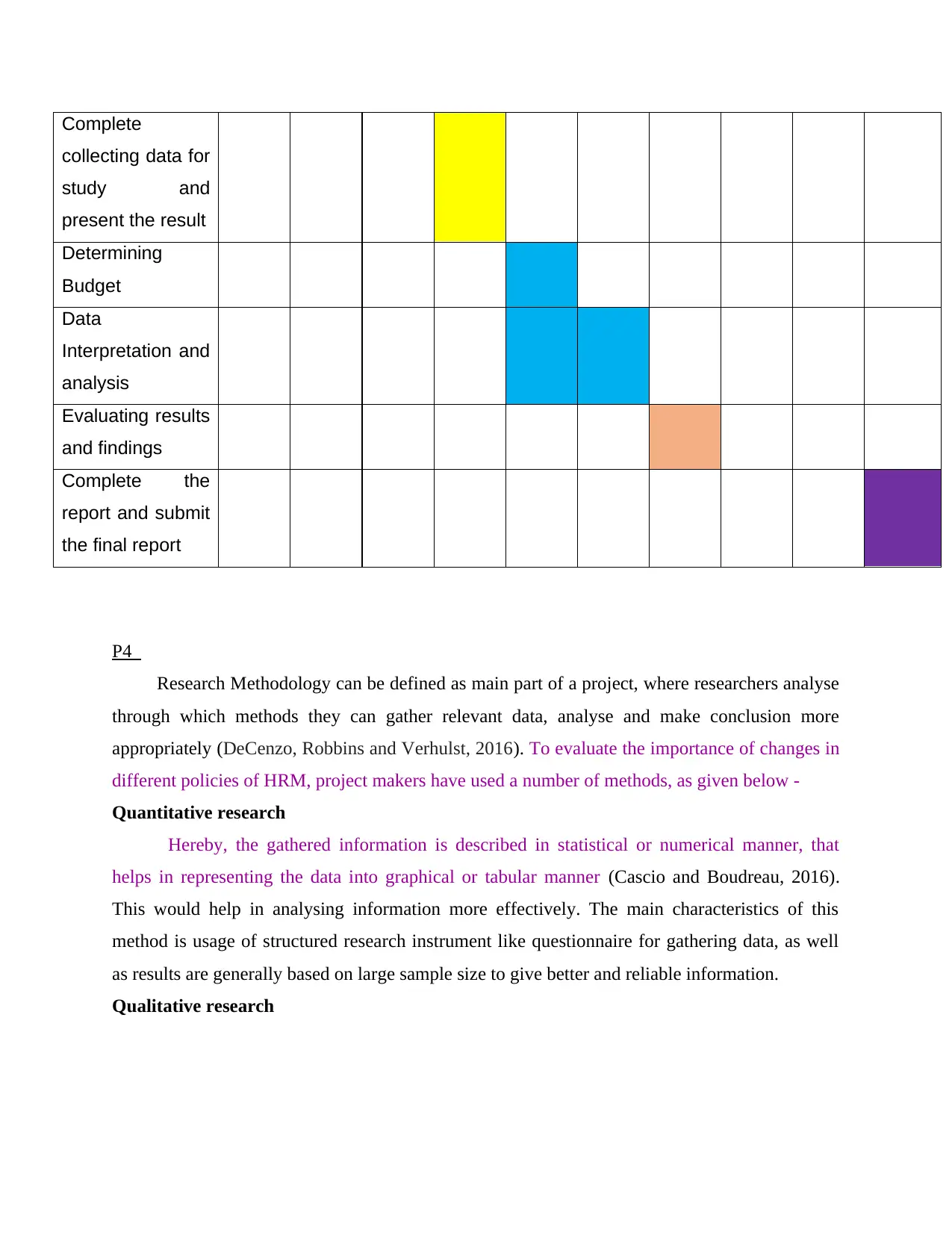
Complete
collecting data for
study and
present the result
Determining
Budget
Data
Interpretation and
analysis
Evaluating results
and findings
Complete the
report and submit
the final report
P4
Research Methodology can be defined as main part of a project, where researchers analyse
through which methods they can gather relevant data, analyse and make conclusion more
appropriately (DeCenzo, Robbins and Verhulst, 2016). To evaluate the importance of changes in
different policies of HRM, project makers have used a number of methods, as given below -
Quantitative research
Hereby, the gathered information is described in statistical or numerical manner, that
helps in representing the data into graphical or tabular manner (Cascio and Boudreau, 2016).
This would help in analysing information more effectively. The main characteristics of this
method is usage of structured research instrument like questionnaire for gathering data, as well
as results are generally based on large sample size to give better and reliable information.
Qualitative research
collecting data for
study and
present the result
Determining
Budget
Data
Interpretation and
analysis
Evaluating results
and findings
Complete the
report and submit
the final report
P4
Research Methodology can be defined as main part of a project, where researchers analyse
through which methods they can gather relevant data, analyse and make conclusion more
appropriately (DeCenzo, Robbins and Verhulst, 2016). To evaluate the importance of changes in
different policies of HRM, project makers have used a number of methods, as given below -
Quantitative research
Hereby, the gathered information is described in statistical or numerical manner, that
helps in representing the data into graphical or tabular manner (Cascio and Boudreau, 2016).
This would help in analysing information more effectively. The main characteristics of this
method is usage of structured research instrument like questionnaire for gathering data, as well
as results are generally based on large sample size to give better and reliable information.
Qualitative research
⊘ This is a preview!⊘
Do you want full access?
Subscribe today to unlock all pages.

Trusted by 1+ million students worldwide
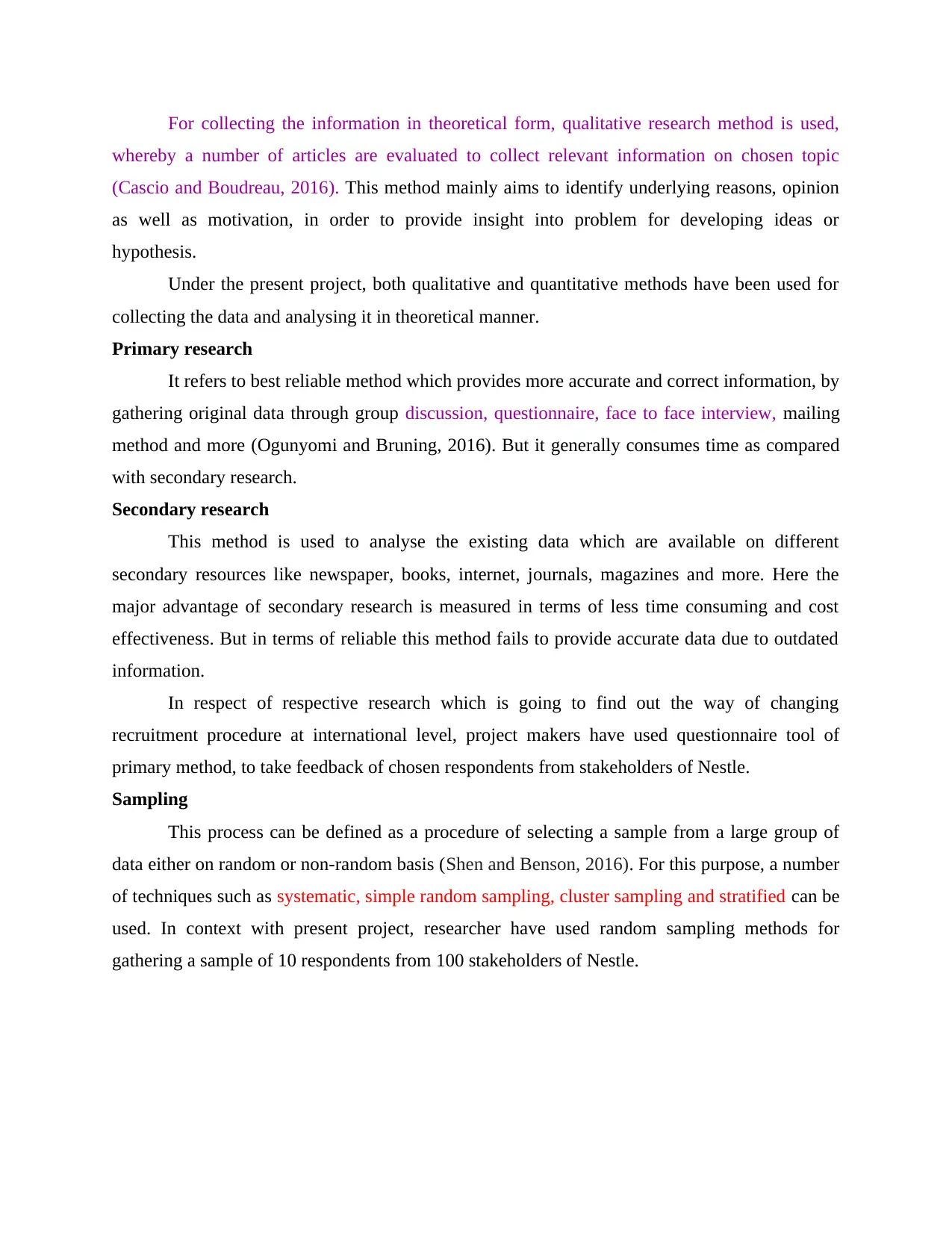
For collecting the information in theoretical form, qualitative research method is used,
whereby a number of articles are evaluated to collect relevant information on chosen topic
(Cascio and Boudreau, 2016). This method mainly aims to identify underlying reasons, opinion
as well as motivation, in order to provide insight into problem for developing ideas or
hypothesis.
Under the present project, both qualitative and quantitative methods have been used for
collecting the data and analysing it in theoretical manner.
Primary research
It refers to best reliable method which provides more accurate and correct information, by
gathering original data through group discussion, questionnaire, face to face interview, mailing
method and more (Ogunyomi and Bruning, 2016). But it generally consumes time as compared
with secondary research.
Secondary research
This method is used to analyse the existing data which are available on different
secondary resources like newspaper, books, internet, journals, magazines and more. Here the
major advantage of secondary research is measured in terms of less time consuming and cost
effectiveness. But in terms of reliable this method fails to provide accurate data due to outdated
information.
In respect of respective research which is going to find out the way of changing
recruitment procedure at international level, project makers have used questionnaire tool of
primary method, to take feedback of chosen respondents from stakeholders of Nestle.
Sampling
This process can be defined as a procedure of selecting a sample from a large group of
data either on random or non-random basis (Shen and Benson, 2016). For this purpose, a number
of techniques such as systematic, simple random sampling, cluster sampling and stratified can be
used. In context with present project, researcher have used random sampling methods for
gathering a sample of 10 respondents from 100 stakeholders of Nestle.
whereby a number of articles are evaluated to collect relevant information on chosen topic
(Cascio and Boudreau, 2016). This method mainly aims to identify underlying reasons, opinion
as well as motivation, in order to provide insight into problem for developing ideas or
hypothesis.
Under the present project, both qualitative and quantitative methods have been used for
collecting the data and analysing it in theoretical manner.
Primary research
It refers to best reliable method which provides more accurate and correct information, by
gathering original data through group discussion, questionnaire, face to face interview, mailing
method and more (Ogunyomi and Bruning, 2016). But it generally consumes time as compared
with secondary research.
Secondary research
This method is used to analyse the existing data which are available on different
secondary resources like newspaper, books, internet, journals, magazines and more. Here the
major advantage of secondary research is measured in terms of less time consuming and cost
effectiveness. But in terms of reliable this method fails to provide accurate data due to outdated
information.
In respect of respective research which is going to find out the way of changing
recruitment procedure at international level, project makers have used questionnaire tool of
primary method, to take feedback of chosen respondents from stakeholders of Nestle.
Sampling
This process can be defined as a procedure of selecting a sample from a large group of
data either on random or non-random basis (Shen and Benson, 2016). For this purpose, a number
of techniques such as systematic, simple random sampling, cluster sampling and stratified can be
used. In context with present project, researcher have used random sampling methods for
gathering a sample of 10 respondents from 100 stakeholders of Nestle.
Paraphrase This Document
Need a fresh take? Get an instant paraphrase of this document with our AI Paraphraser
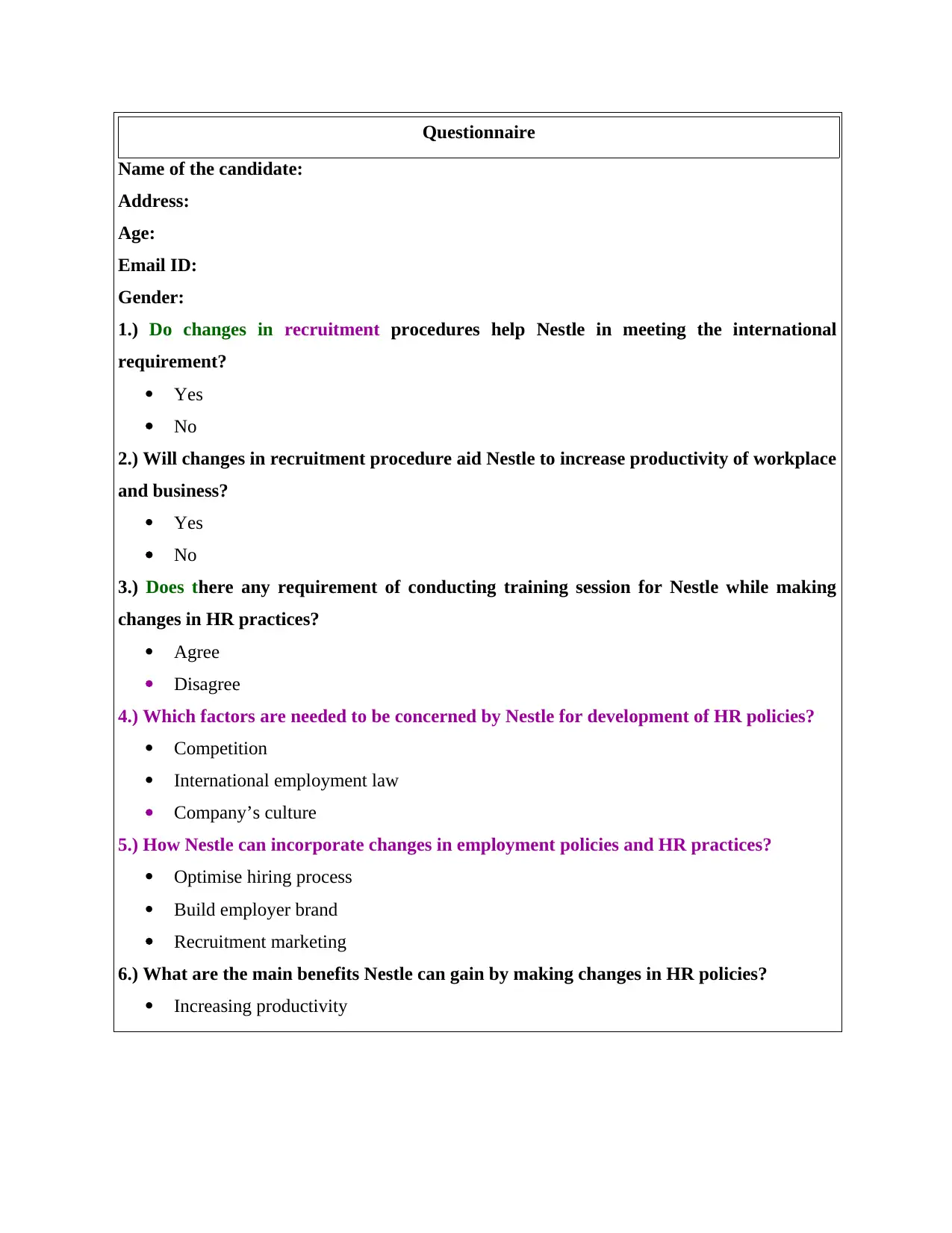
Questionnaire
Name of the candidate:
Address:
Age:
Email ID:
Gender:
1.) Do changes in recruitment procedures help Nestle in meeting the international
requirement?
Yes
No
2.) Will changes in recruitment procedure aid Nestle to increase productivity of workplace
and business?
Yes
No
3.) Does there any requirement of conducting training session for Nestle while making
changes in HR practices?
Agree
Disagree
4.) Which factors are needed to be concerned by Nestle for development of HR policies?
Competition
International employment law
Company’s culture
5.) How Nestle can incorporate changes in employment policies and HR practices?
Optimise hiring process
Build employer brand
Recruitment marketing
6.) What are the main benefits Nestle can gain by making changes in HR policies?
Increasing productivity
Name of the candidate:
Address:
Age:
Email ID:
Gender:
1.) Do changes in recruitment procedures help Nestle in meeting the international
requirement?
Yes
No
2.) Will changes in recruitment procedure aid Nestle to increase productivity of workplace
and business?
Yes
No
3.) Does there any requirement of conducting training session for Nestle while making
changes in HR practices?
Agree
Disagree
4.) Which factors are needed to be concerned by Nestle for development of HR policies?
Competition
International employment law
Company’s culture
5.) How Nestle can incorporate changes in employment policies and HR practices?
Optimise hiring process
Build employer brand
Recruitment marketing
6.) What are the main benefits Nestle can gain by making changes in HR policies?
Increasing productivity
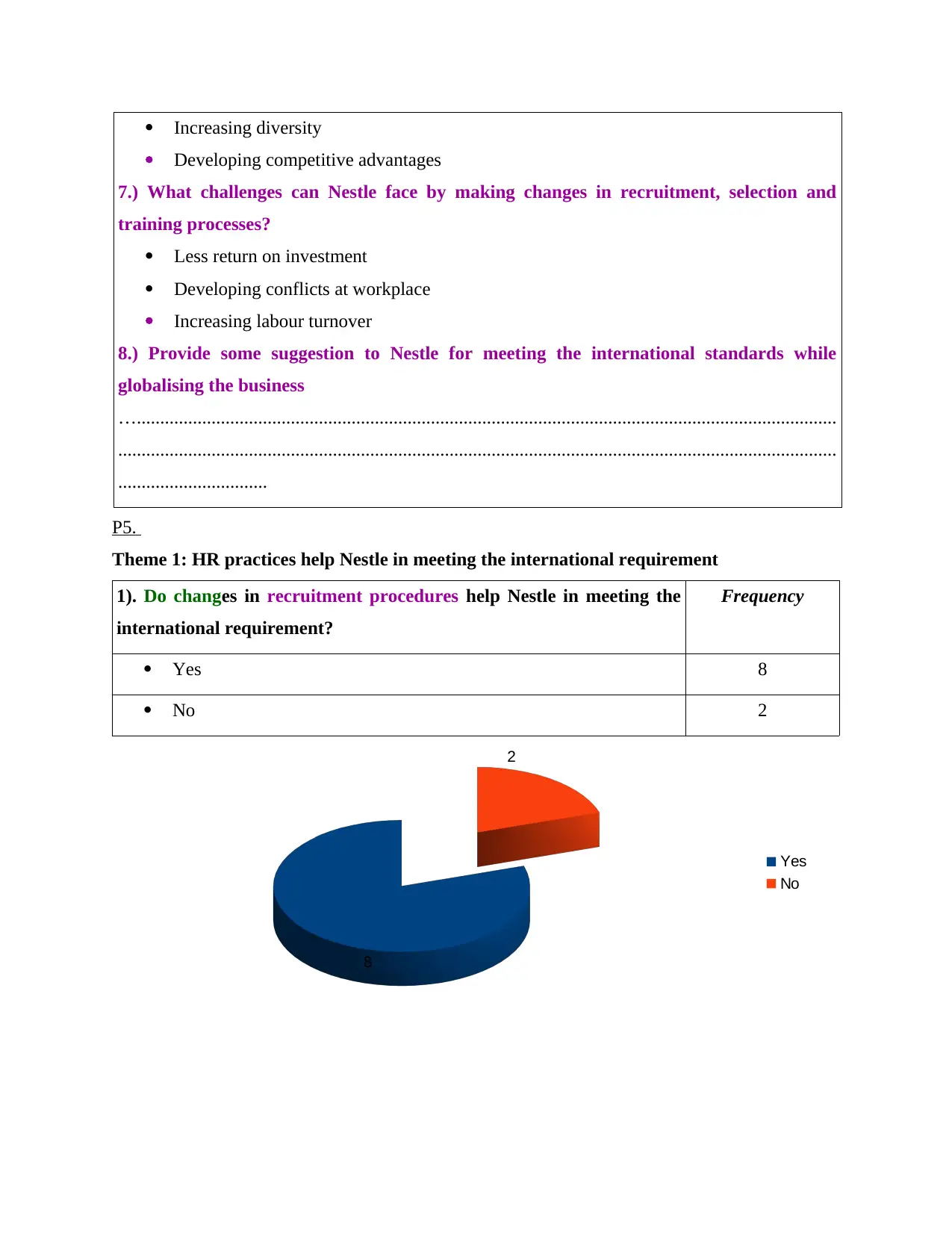
Increasing diversity
Developing competitive advantages
7.) What challenges can Nestle face by making changes in recruitment, selection and
training processes?
Less return on investment
Developing conflicts at workplace
Increasing labour turnover
8.) Provide some suggestion to Nestle for meeting the international standards while
globalising the business
…......................................................................................................................................................
..........................................................................................................................................................
................................
P5.
Theme 1: HR practices help Nestle in meeting the international requirement
1). Do changes in recruitment procedures help Nestle in meeting the
international requirement?
Frequency
Yes 8
No 2
8
2
Yes
No
Developing competitive advantages
7.) What challenges can Nestle face by making changes in recruitment, selection and
training processes?
Less return on investment
Developing conflicts at workplace
Increasing labour turnover
8.) Provide some suggestion to Nestle for meeting the international standards while
globalising the business
…......................................................................................................................................................
..........................................................................................................................................................
................................
P5.
Theme 1: HR practices help Nestle in meeting the international requirement
1). Do changes in recruitment procedures help Nestle in meeting the
international requirement?
Frequency
Yes 8
No 2
8
2
Yes
No
⊘ This is a preview!⊘
Do you want full access?
Subscribe today to unlock all pages.

Trusted by 1+ million students worldwide
1 out of 35
Related Documents
Your All-in-One AI-Powered Toolkit for Academic Success.
+13062052269
info@desklib.com
Available 24*7 on WhatsApp / Email
![[object Object]](/_next/static/media/star-bottom.7253800d.svg)
Unlock your academic potential
Copyright © 2020–2025 A2Z Services. All Rights Reserved. Developed and managed by ZUCOL.





